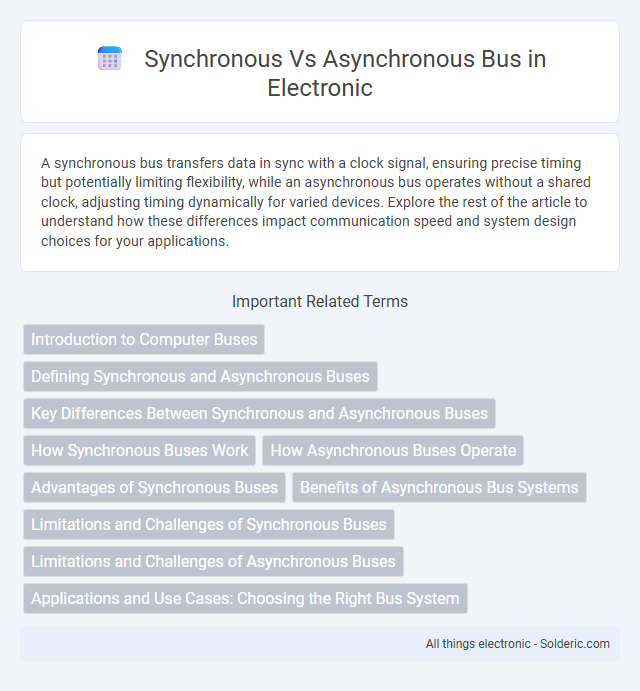A synchronous bus transfers data in sync with a clock signal, ensuring precise timing but potentially limiting flexibility, while an asynchronous bus operates without a shared clock, adjusting timing dynamically for varied devices. Explore the rest of the article to understand how these differences impact communication speed and system design choices for your applications.
Comparison Table
| Feature | Synchronous Bus | Asynchronous Bus |
|---|---|---|
| Clock Signal | Uses a global clock for timing | No global clock; uses handshake signals |
| Data Transfer | Data synchronized with clock pulses | Data transfer occurs when devices are ready |
| Speed | Faster due to fixed timing | Slower because of wait states |
| Complexity | Simple control logic | More complex control and handshake logic |
| Design Cost | Lower | Higher |
| Reliability | Less tolerant to timing variations | More tolerant to variations and delays |
| Use Case | Used where timing can be strictly controlled | Used in systems with variable device speeds |
Introduction to Computer Buses
Computer buses transfer data between the CPU, memory, and peripherals, utilizing two main types: synchronous and asynchronous buses. Synchronous buses operate with a shared clock signal, ensuring data transfers happen at precise intervals, which enhances speed and reliability. Your choice between these buses impacts system timing coordination and overall performance efficiency in computing devices.
Defining Synchronous and Asynchronous Buses
A synchronous bus operates based on a shared clock signal that coordinates data transfer timing across all devices, ensuring precise and predictable communication. In contrast, an asynchronous bus does not rely on a common clock, utilizing handshaking signals to manage data exchange and allow devices to communicate at their own pace. Understanding these definitions helps you determine the best bus architecture for your system's timing and performance requirements.
Key Differences Between Synchronous and Asynchronous Buses
Synchronous buses operate with a shared clock signal, ensuring data transfers occur at precise time intervals, which enables predictable communication speeds and coordination across connected devices. Asynchronous buses, however, use handshaking signals rather than a common clock, allowing data transfers to occur at irregular intervals based on device readiness, which offers greater flexibility for varying device speeds. Your choice between these bus types depends on whether you prioritize timing accuracy and speed consistency (synchronous) or adaptable communication with diverse peripherals (asynchronous).
How Synchronous Buses Work
Synchronous buses operate by transmitting data synchronized to a shared clock signal, ensuring that all components communicate in harmony during specific clock cycles. This coordination allows predictable timing and efficient data flow between the processor, memory, and peripherals. Your system benefits from reduced latency and increased reliability in data transfer due to this precise timing control.
How Asynchronous Buses Operate
Asynchronous buses operate using handshaking signals instead of a shared clock, allowing devices to communicate at different speeds without requiring synchronization. Each data transfer is controlled by request and acknowledgment signals, ensuring that the sender transmits data only when the receiver is ready. This flexibility improves compatibility with diverse components and enhances overall system efficiency by reducing timing constraints.
Advantages of Synchronous Buses
Synchronous buses offer precise timing control by coordinating data transfers with a clock signal, enhancing data integrity and reducing latency. These buses enable consistent data rates and simplified timing analysis, which boosts overall system performance in real-time applications. Your system benefits from synchronized communication that minimizes timing errors and optimizes hardware efficiency.
Benefits of Asynchronous Bus Systems
Asynchronous bus systems offer greater flexibility and efficiency by allowing data transfers without a global clock signal, reducing wait times during communication. They adapt to variable data transfer speeds and can improve overall system performance by eliminating idle cycles often caused by clock synchronization. This results in lower power consumption and enhanced compatibility with heterogeneous components in embedded and distributed systems.
Limitations and Challenges of Synchronous Buses
Synchronous buses face limitations such as limited maximum clock speed due to signal propagation delays and timing skew between devices, which restrict overall system performance. The need for precise clock synchronization across all components leads to complexity in design and higher power consumption. Your system may encounter scalability challenges as synchronous buses often struggle to maintain reliable communication with increasing device counts and longer bus lengths.
Limitations and Challenges of Asynchronous Buses
Asynchronous buses face limitations such as increased complexity in timing control due to the absence of a common clock signal, leading to difficulties in data synchronization and potential timing hazards. These challenges include longer latency and lower throughput compared to synchronous buses, as handshaking protocols introduce overhead and delay. Debugging and designing for metastability issues further complicate the implementation of asynchronous bus systems, affecting their reliability and performance in high-speed applications.
Applications and Use Cases: Choosing the Right Bus System
Synchronous buses are ideal for applications requiring high-speed data transfer with precise timing, such as real-time embedded systems and microprocessor communication in servers. Asynchronous buses suit environments with variable data rates and unpredictable latency, making them common in peripheral devices and network communication interfaces. Selecting the right bus system depends on factors like timing constraints, data transfer volume, and system complexity to optimize performance and resource utilization.
synchronous vs asynchronous bus Infographic

 solderic.com
solderic.com